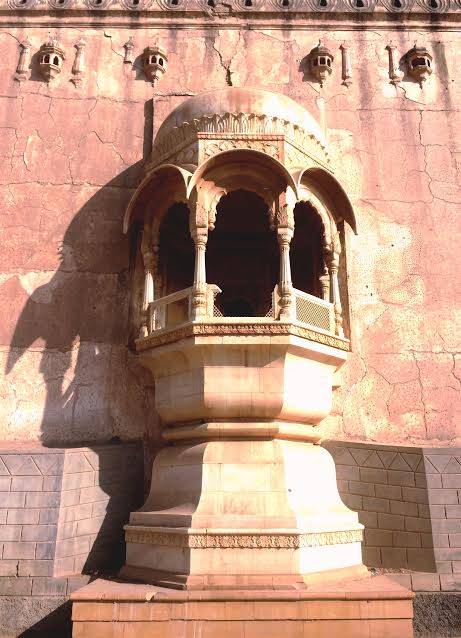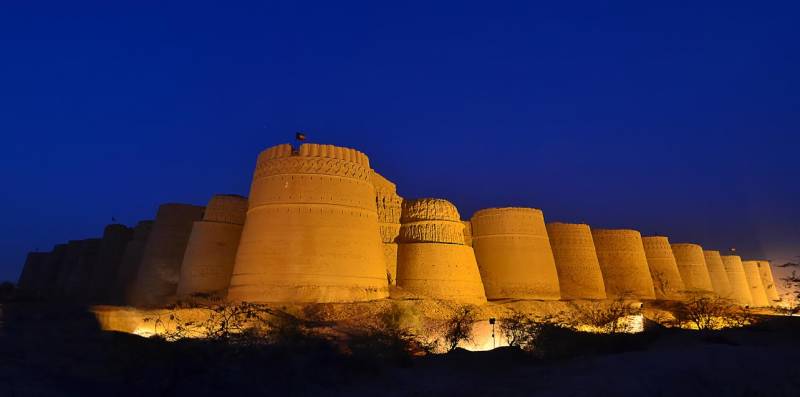After spending a beautiful night in Cholistan, the very next day my friends took the train back to Lahore and I proceeded to Fatima Fertilizer Company near Sadiqabad, Punjab’s last town before Sind. My sister who lives there had been asking me for ages to come and stay with them. If I hadn’t done so this year, she would’ve disowned me for sure. So, I spent three delightful days in tranquility and luxury of FFC and enjoyed their hospitality. Plan was that on the decided day, I would leave for Bahawalpur and a friend from Lahore would join me there. I spent all my time at FFC waiting and making plans but this friend never came. At last, I was left without a travel companion and it seemed that the plan was coming to an end.
Just to take a chance, I called PTDC motel Bahawalpur. They were completely booked for that week. On my request they gave the contact of a reliable driver to whom they usually recommended their clients. On the other side of the line a man spoke in a very pleasant and professional tone. This was Mr. Suhail Anwar, the tourist guide. He told me that he wasn’t just a driver but a PTDC certified tourist guide with an experience of 27 years in Bahawalpur and he could show me places which are usually out of bound for public. Suhail had struck the right chord. I took a leap of faith and for the first time ever, decided to travel on my own, to an unfamiliar destination with a stranger as a guide.

Derawar Cannon
 /
/
Arabic description on Derawar Cannon
I took the first bus next morning and kept reading Will Durant’s Fallen Leaves during three and a half hours on the road. We reached Bahawalpur around 11:30 am and the first person I saw after stepping down from the bus was Suhail. He most graciously welcomed me and insisted on carrying the luggage. I was embarrassed because he was a man double my age and working as a tourist guide since before I was born. He offered me the back seat of the car and stood with the door open. I preferred the front seat and asked him to cut short the formalities. Because I couldn’t stay for the night in Bahawalpur, I had just a few hours of the day to explore the place. So, I crossed half the places on my ‘to visit’ list for next time and we immediately left for Derawar Fort which was a little less than a hundred kilometers from Bahawalpur, inside Cholistan desert. After sometime on the highway we took a narrow country road. It made its way through green fields, orchards and rural marketplaces. One beautiful feature of this part of Punjab is its date palm, mango and orange orchards which are rare in northern Punjab. After half an hour or so, green of the fertile land gave in to light brown of the desert. Now we were in Cholistan and as far as the eye could see there was nothing but desert sands and scattered trees and bushes. And then the mighty bastions of Derawar came into view. The great fort stood in the heart of Cholistan in all its glory and magnificence for over a thousand years. Its forty great towers need no chronicle of history to prove the power and might of its masters.
We parked the car near semi demolished structures with the magnificent Abbasid Mosque on our right. Suhail told me that the place used to be a marketplace and a great center of trade just outside the fort in old days. Most probably the fort was surrounded and guarded by another great wall, traces of which can still be found. We made our way through the ruins and passed through a beautiful arched gateway. Its threshold was buried under desert sand. It gave access to the fort’s only entrance, a high gate hidden between great towers. Gatekeepers opened a small window in the gate for us to enter and from shining sunlight we stepped into the darkness of a quarter-circle shaped tunnel which leads inside the fort.

Gateway towards the fort
 /
/
Ruined guest houses and zenana quarters inside the fort

Jharoka of the Royal Abbasid Mosque
Derawar Fort is a picture of ruin and desolation. It is although a national symbol of Pakistan but not a public property and still legally owned by Bahawalpur’s royal family. Until a couple of decades ago, formal permission to visit the fort was issued from Sadiqgarh Palace by the Nawab. Gone are days of the Raj when Bahawalpur was one of the richest princely states in British India. The royal family hasn’t handed over the fort to the government and lacks resources to maintain such a grand structure. Besides, they are too busy fighting over their grandfather’s wealth. The present nominal Nawab of Bahawalpur, Salahuddin Abbasi is the last Nawab’s grandson. He has strong political standing in the area, wears a fez cap, holds grievances against governments of Lahore and Islamabad and demands a separate province. A friend told me that when they visited Derawar, its doors were closed for public and flags of the princely state of Bahawalpur had been hoisted on all four corners of the fort owing to an ongoing conflict between the Nawab and the Punjab government.
There were a few scattered trees and bushes; otherwise the vast ground in the middle of the fort was devoid of any greenery. An old cannon stood in the middle of the ground. Arabic inscription over its trunk read something like God’s sword and victory in the battle. The color of wood used in its wheels and carrier had faded but it was still intact considering that the cannon had remained under open sky for so many years. Who knows when was the last time this beautiful piece of artillery was fired in a battle or to commemorate an occasion and then silenced forever.
The most remarkable feature of Derawar’s structure is its high bastions rising into the sky from sands of Cholistan, like forty formidable knights guarding the great fort. They are constructed with mud bricks arranged in patterns leaving a gun slot every few feet. From above the bastions, there is a breathtaking view of the desert spread far and wide. These bastions are fascinating structures and make Derawar what it is. Due to no maintenance, some of them have developed cracks; others have lost the entire outer layer of bricks and mud.

Magnificent view of the Abbasid Mosque

Main arch of the Abbasid Mosque
Western part of the fort holds remains of what were once the Nawabi harem and the guest houses. These structures are made up of long lines of symmetrical rooms and arched verandas. They are in a very precarious condition. Ceilings have partially demolished and floors have faded under desert sand. Doors and fire places are broken. Final remains of exquisite tile work, carved wooden doors and arches and decorated wooden ceilings can still be seen at places and betray a glimpse of their glorious past. These buildings were beautifully designed and tastefully decorated. Once they fell into disuse, climatic erosion and looters robbed their beauty. Alas, all beautiful things come to an end.
There were lines of prison cells near the northern wall and a high haveli over the north eastern corner tower of the fort. It was used by the most senior or most respectable begum in the Nawabi household. Through a round arch, an inclined path leads to the haveli. It consists of a small courtyard and a room. Four walls of the room are punctured by a dozen windows all carved out of wood. Columns of the walls between windows are decorated with beautiful fresco paintings. Haveli offers an exquisite view of the desert and pearl white domes of the royal Abbasid Mosque. I could see a cluster of domes in a compound beyond the mosque. Suhail told me that it was the royal graveyard. Through centuries as per tradition, Nawabs of Bahawalpur had been crowned and buried in the desert in front of the great walls of Derawar.
Abbasid Mosque was constructed on orders of Nawab Bahawal Khan Abbasi in 1849. We entered the mosque through a side entrance. The main structure is made entirely out of white marble. Its beautifully carved arches, decorative marble work, calligraphy and attention to detail make it no less than any great Mughal mosque. One unique feature of the mosque is a beautiful marble jharoka inside the main arch facing Derawar. Three beautiful pearl like domes rest on the mosque roof.

Nawabi Cemetery

Tombs of Badshah Begums
The royal graveyard is a strictly private domain. Only members of the royal family are permitted to visit their ancestor’s graves, but Suhail was an old guide and everyone’s friend. Just outside the graveyard compound, there was a small settlement of shepherds and cattlemen. Keys to the graveyard were entrusted to an elder of the community. After a lot of persuasion and a promise that we won’t take pictures he opened the locks and we stepped in through a classic Mughal style doorway. Complete silence reigned inside the graveyard. The complex was very well maintained and guarded by a high wall. Inside, there were several Multan-style domed mausoleums of badshah begums long forgotten. Relatively new graves were simpler and out in the open. Among many others, there was the grave of Prince Haroon ur Rasheed Abbasi, second son of Nawab Sir Sadiq Muhammad Khan Abbasi. He served in Pakistan’s Foreign Service as ambassador to several countries and died in a car accident near Bahawalpur in 1972.
The most fascinating feature of the royal graveyard was a simply designed but beautifully decorated long rectangular tomb. There was a long line of royal graves. Nawabs who ruled over Bahawalpur for centuries were buried in this hall under a gilded mirrored ceiling. Walls were decorated with blue tiles and floral fresco. Decorations were illuminated and marble work was glowing from the light coming through some two dozen windows in all four walls of the hall. There were a few small graves hiding the remains of princes who never made it beyond childhood. The room was nothing less than sacred for the caretaker. The interior of this tomb was so fascinating, that to his displeasure I couldn’t resist taking pictures. Last two places in the hall are reserved for the present Nawab and his heir.
When we stepped outside the graveyard, I saw a herd of cows, goats and sheep passing, returning home after the day’s grazing. Bells hanging with their necks were creating a rhythm more beautiful than an orchestra. I stood there trying to absorb the beauty of the moment in my eyes and ears. Acacia trees, desert sands, blue sky and mellowness of jingling bells, Cholistan was eternal. So said Khwaja Farid;
Pur wehshat sanjhri Rohi
Ae dil deewani mohi…
(Has hauntingly deserted “Rohi” with calm
Captivated my heart out of its charm)
Continued…






